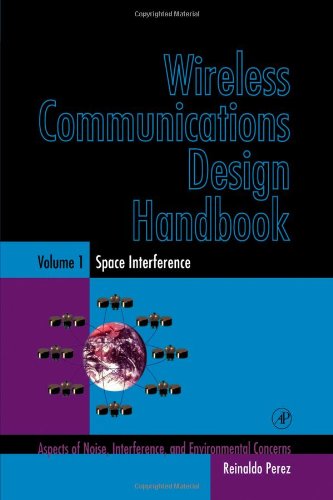Reinaldo Perez9780125507219, 0-12-55072-1-6
Table of contents :
Wireless Communications Design Handbook……Page 4
Copyright Page……Page 5
Contents……Page 6
Acknowledgments……Page 8
Preface……Page 10
Introduction……Page 14
1.1 Interference between Satellite-Earth Station Links……Page 20
1.2 Interference between Broadcasting Terrestrial Stations and Satellite Earth Stations……Page 22
1.3 Technical Protection against RF Interference……Page 27
1.4 Pager Antennas and Their Performance……Page 29
1.5 Cellular Phone Structures……Page 36
1.6 Base-Station Antenna Performance……Page 43
1.7 Environmental Factors in Antenna Selection……Page 53
1.8 Performance of Dipole Arrays……Page 56
1.9 Passive Repeater Technology for PCS Systems……Page 60
1.10 Use of Smart Antennas……Page 64
1.11 Path Loss……Page 73
1.12 Co-channel Interference……Page 75
1.13 Adjacent Channel Interference……Page 77
1.14 Rayleigh Fading in Quasi-static Systems……Page 78
2.1 Noise Factor……Page 80
2.2 Field Parameters……Page 81
2.3 Antenna Temperature……Page 82
2.5 Thermal Radiation……Page 83
2.6 Natural Noise at the Earth’s Surface……Page 84
2.7 Atmospherics……Page 85
2.8 Extraterrestrial Noise……Page 86
2.9 Quiet and Disturbed Plasmasphere……Page 95
2.10 Tracking and Watching for Space Storms……Page 100
2.11 Space Weather Channel……Page 103
2.12 Effects on Satellites……Page 105
3.1 Total Energy—Deterministic Waveforms……Page 107
3.2 Total Energy—Stochastic Waveforms……Page 114
3.3 Peak Current Noltage–Deterministic Waveforms……Page 115
3.4 Peak Current—Stochastic Waveforms……Page 125
4.1 The Modified Nonlinear Transfer Function Approach……Page 127
4.2 Desensitization……Page 135
4.3 Gain Compression and Gain Expansion……Page 139
4.4 Intermodulation……Page 140
4.5 Cross Modulation……Page 149
4.6 Spurious Responses……Page 156
5.0 Introduction……Page 161
5.1 Signal-to-Interference Ratio……Page 162
5.2 Coordination Area Based on Great-Circle Propagation……Page 167
5.3 Coordination Area for Scattering by Rain……Page 174
5.4 Interference between Space and Surface Stations……Page 178
5.5 Procedures for Interference Analysis……Page 179
5.6 Permissible Level of the Interfering Emissions……Page 182
5.7 Link Communications Systems Design……Page 184
5.8 Allocation of Noise and Signal-to-Noise Ratio……Page 187
5.9 Diversity Reception……Page 188
References……Page 193
Index……Page 199

Reviews
There are no reviews yet.